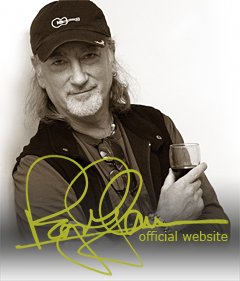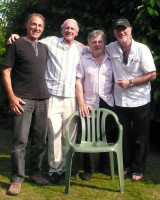The Madisons
Around 1960, when I was about 14, my father, mother and my sister Christine moved west out of London and settled in Pinner, Middlesex where my parents took over The Oddfellows Arms pub. My sister and I had to change schools of course, and I found myself going to Harrow County Grammar School for Boys on Gayton Road, Harrow. The syllabus was different from my previous school, Sir Walter St.John’s Grammar School in Battersea, and that, coupled with the fact that I was a bit of a dreamer, meant that I was held back for a year, something that some would be embarrassed about, but I didn’t mind; it was an extra year before I really had to get my act together and get a job or something. I never thought much about the future then. Nothing much has changed.
Harrow County was not, or didn’t seem to be, as historically rooted or as prestigious as St.John’s; the boys were rougher, the accents liberally littered with dropped aitches and glottal stops, and it all seemed rather grimy. We wore green blazers and embarrassing caps, prefects were cruel, teachers wore gowns and were often quite vicious in their punishments and the headmaster was a throwback to a more puritanical time. His nickname was ‘Square’ and he definitely did not approve of the burgeoning fashions in music or clothing. Compared to today the school was positively Dickensian. One of its main claims to fame was that R.J. Mitchell the designer of the Supermarine seaplane that won the Schneider Trophy, a prototype of the Spitfire, was an old boy. The school as such no longer exists but the building is still there and there is a stained glass window of the plane over the main entrance.
My class was 3D, the lowest of the four third year classes and consequently not exactly crammed with the most academic of scholars. Each class consisted of about 30 boys. I settled into my new environment and started to make a few friends, amongst who were Tony Barham, Mike Duvall and Dave Collis. We all shared a passion for pop music. I brought my cheap Spanish guitar to school one day and Tony showed me, on his far better sounding guitar, a few chords beyond the basics that I had more or less mastered. They were enough for us to attempt songs by Lonnie Donegan, Eddie Cochran, Buddy Holly, or the more folky stuff from Joan Baez, Pete Seeger, Josh White and the like. Increasingly, we had impromptu jams in the classroom after school had finished for the day. The rebellious rock’n’roll of the 50s had by now morphed into pop, purveyed by pretty boys with unreasonable quiffs or identically dressed girl groups, and all part of a production line of stars created and controlled (and milked) by the song-writing sweatshops of Tin Pan Alley or the Brill Building.
Every December the school put on the Christmas Entertainments, a musical concert in aid of the old folks of Harrow, featuring various bands and combos drawn from the pupils. Sometime before the show I was walking past the old gym one day when I heard what I thought was Poetry In Motion by Johnny Tillotson being played alarmingly loudly. I peeked through the door and was stunned to see that it was a band, playing live, rehearsing for the upcoming concert. It sounded just like the record. I was mesmerized. That moment changed my life.
That band was The Lightnings and after I saw them perform in the show a week or so later, I determined that our little group of friends should form a band in time for the following year’s concert. Tony, whose acoustic guitar had by now been replaced by a Hofner Colorama, became the rhythm guitarist because he knew a lot of chords, and Dave, who owned a real electric solid body guitar, a black and white Eastwood Supro that was beyond cool, became our lead guitarist. That left me with my cheap, pathetic Spanish guitar, so I naturally became the bass player, removing the two top strings and clamping a primitive pick-up over the sound hole. It would be to me what seemed like eons before I graduated to a red solid body Hofner bass guitar, a copy of the Fender Precision that The Shadows had made famous.
The three of us needed a drummer and a singer and so we approached Harvey Shield, who could often be heard rehearsing drums with the pipe and drum school military band. The conversation went something like, “Ere, Harvey, ‘ave got your own kit?” Having replied in the affirmative he was duly invited into our fledgling enterprise. Mike Duvall was good looking, played pretty good piano and also sang so he became the last one to complete our line-up.
We settled on the name because American pop music was far cooler than its British counterpart and one of the few American names we had heard of was Madison Square Garden. Of course, we would never consider having the word ’square’ in our name – it was a very powerful word describing anything that was uncool – and so we became The Madisons.
By the end of the following year we had done a few local gigs, mostly birthday parties, which we played for free, and considered ourselves ready for the next Christmas Entertainments where we would play second fiddle to the already established Lightnings. The three songs we performed were Night of the Vampire (Howlin’ Wilson), On The Rebound (Floyd Cramer) and I’m A Moody Guy (Shane Fenton and The Fentones – later to become Alvin Stardust). Of the two concerts, the first went well enough but our sole, small Watkins amplifier owned by Tony couldn’t really handle all of us being plugged into it. Bert Weedon, a guitar legend at that time, had a son in the school and came backstage after the show to meet all the bands. We were star struck meeting him. He mentioned the distortion from our wimpy little amplifier and offered to lend us his shiny new Selmer combo amp for the next show. What a thrill; it even had castors and his famous name in a leather baggage tag attached to the handle! Boy, were we proud.
By the following year we had improved quite a bit, acquired some better equipment (Tony and I constructing bass cabinets in his parents’ front room) and became serious rivals to The Lightnings. Over the next couple of years several school dances were held where the two bands played, each having their own group of fans. Within a couple of years The Madisons and The Lightnings combined as various members left school for universities or jobs. A year or so later we changed our name to Episode Six, but that’s another story.
The reason I am reliving and recounting this brief history is that on June 26th 2010 there was an Episode Six reunion at Sheila’s house in England. Most of us in Episode Six have been in touch over the years but this time it was special; Dave Collis, whom I hadn’t seen in 47 years, was there so it was the first ever Madisons reunion. The only one missing was Mike Duvall who sadly passed away a few years ago.
Later that night, at my sister Christine’s 60th birthday party, the band Beat:Root played. Using their gear, The Madisons got up and played a few of the old songs from those years, then Sheila got on stage and it turned into an Episode Six jam. The day was an amazing foray into the past.
The photograph, left to right; Dave Collis, Harvey Shield, Tony Barham, Roger Glover and not seated, Mike Duvall.
RG
2 thoughts on “The Madisons”


Browsing around, I tripped over references to “The Madisons reunion”. I was touched by the empty chair gesture. I know Mike was always proud of what you achieved after The Madisons. I remember the days of the group practicing in the our lounge at Harrow and Dad cramming everyone and kit in his old Ford Prefect on the way to gigs!
Regards
Richard Duvall (Mike’s little brother)
I also remember seeing The Lightnings rehearsing “Poetry in Motion”, but from the balcony of the main hall.